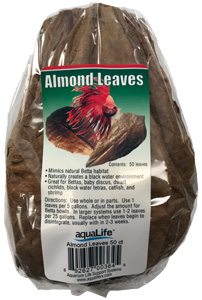 Breeders in Southeast Asia noticed long ago that fish and shrimp that lived in waters next to any Terminalia Catappa tree, or the tropical Indian almond tree from the Leadwood tree family, were found to be healthier and more vibrant than their counterparts in other waters. Almond leaves have been used in the aquarium industry for many years, but those in the beginning stages of the hobby may not know all of the benefits that these leaves pack for shrimp, as well as various fish species. The leaves were found to help keep fish healthy with strong antibacterial properties and promote better breeding.
When the dried leaves fall into the water, they will emit a strong, brown dye that is full of organic acids like tannic acids, which gradually turn the water into a red-brown color, similar to tea, and effectively reduce the ph levels in water, releasing it’s rich organic compounds such as humic acids, flavanoids, and tannins into the water, which absorbs harmful chemicals. Not only do shrimp benefit from almond leaves, but fish that benefit from almond leaves are baby discus, dwarf cichlids, killi fish, catfish, and black water tetras.
Breeders in Southeast Asia noticed long ago that fish and shrimp that lived in waters next to any Terminalia Catappa tree, or the tropical Indian almond tree from the Leadwood tree family, were found to be healthier and more vibrant than their counterparts in other waters. Almond leaves have been used in the aquarium industry for many years, but those in the beginning stages of the hobby may not know all of the benefits that these leaves pack for shrimp, as well as various fish species. The leaves were found to help keep fish healthy with strong antibacterial properties and promote better breeding.
When the dried leaves fall into the water, they will emit a strong, brown dye that is full of organic acids like tannic acids, which gradually turn the water into a red-brown color, similar to tea, and effectively reduce the ph levels in water, releasing it’s rich organic compounds such as humic acids, flavanoids, and tannins into the water, which absorbs harmful chemicals. Not only do shrimp benefit from almond leaves, but fish that benefit from almond leaves are baby discus, dwarf cichlids, killi fish, catfish, and black water tetras.
Humic and tannic acids are a mixture of complex partially decomposed organic materials, the end product of the conversion of things like plant and animal debris. They are some of the most important components of fertile soil.
- – Anti-inflammatory
- – Anti-parasitic
- – Anti-bacterial
- – Anti-fungal
 AquaLife offers a 4-pack and 50-pack of almond leaves. They are larger in size and ready to use! The easiest method is to put the leaf directly in your aquarium. You may want to use a couple of small leaves or half of a large leaf for a 4 gallon betta tank. If you are using the leaves for a larger community tank, we recommend putting 2-3 large (or 4-6 small) leaves for every 25 gallons.
AquaLife offers a 4-pack and 50-pack of almond leaves. They are larger in size and ready to use! The easiest method is to put the leaf directly in your aquarium. You may want to use a couple of small leaves or half of a large leaf for a 4 gallon betta tank. If you are using the leaves for a larger community tank, we recommend putting 2-3 large (or 4-6 small) leaves for every 25 gallons.
Read More: 8 Best Algae Eaters for Your Planted Tank
You do not really need to change the leaves until they begin to disintegrate in about 3 weeks. In fact, if you have shrimp or pleco, they will devour them when they start to disintegrate. If you don’t have a problem with seeing decaying leaves in your tank, you don’t have to change them more frequently than once a month. The issue is if you have a sponge or box filter. The disintegrated leaves will clog up your filter, requiring more frequent changes when the leaves begin to decompose. Aquarists who keep fish native to soft, acidic, and tannin rich waters, such as the Betta fish, commonly use Almond leaves to mimic the natural conditions of their species in aquaria. Adding Almond leaves to a tank can help trigger spawning since compounds released by the leaves will alter the chemistry of the water, making the aquarium more similar to the habitat from which the fish hails.Related Articles:
- • Aquarium Botanicals: Guava Leaves
- • Aquarium Botanicals: Alder Cones
- • Aquarium Botanicals: Mulberry Leaves
Contact the experts at SevenPorts today for more information about almond leaves!



